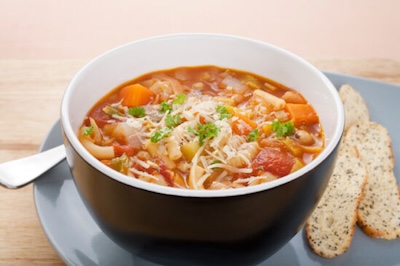
Recently, MSG in food has been a featured topic in a variety of outlets, from food blogs demonstrating how to get the umami flavor we crave to lifestyle websites discussing why monosodium glutamate has gotten a bad rap for many years – and how that perception has changed thanks to scientific research.
There’s MSG in That?
 Many of us don’t realize it, but we may already be enjoying MSG in food items we commonly eat. MSG is used in packaged soup mixes, snacks, and seasoning blends to reduce sodium while maintaining great flavor. So just how many foods in our cupboards are getting some of their flavor depth from MSG? We read the ingredient labels on our favorites and found this: Snacks like potato chips, pretzels, and cheese puffs, seasonings, sauces, and salad dressings are just some of the foods that may contain MSG as an ingredient. Quick-service food, including pizza and burgers, and frozen meals can include MSG with the same sodium-reduction benefits.
Many of us don’t realize it, but we may already be enjoying MSG in food items we commonly eat. MSG is used in packaged soup mixes, snacks, and seasoning blends to reduce sodium while maintaining great flavor. So just how many foods in our cupboards are getting some of their flavor depth from MSG? We read the ingredient labels on our favorites and found this: Snacks like potato chips, pretzels, and cheese puffs, seasonings, sauces, and salad dressings are just some of the foods that may contain MSG as an ingredient. Quick-service food, including pizza and burgers, and frozen meals can include MSG with the same sodium-reduction benefits.
In an interview with Snack Food and Wholesale Bakery, Haya Anabtawi, senior principal food scientist with Ajinomoto Health and Nutrition North America, noted, “In snacks, umami can be delivered via ingredients like MSG and yeast extracts to amplify savory notes while maintaining saltiness perception in products that have reduced sodium. MSG is an effective tool to reduce sodium while maintaining taste.”
Using MSG in Food to Improve Favorite Dishes
The MSG Martini has received a lot of coverage over the past few years, and Chowhound has suggestions to expand the use of MSG to other cocktails by adding a few shakes of the ingredient or using an MSG solution when mixing drinks.
Tasting Table recommends incorporating MSG to boost the flavor of homemade pho: “[W]e don’t shy away from enhancing all the flavors of the broth and kicking up the umami by adding some MSG to the mix. A recommendation is to start with about 1/4 teaspoon and go from there.”
Better Homes & Gardens also notes that MSG can enhance the flavor of savory soups and does so while adding less sodium than salt would – a great tip considering how high in sodium many soups tend to be.
Public Perception of MSG
 More reporting in health and lifestyle publications encourages consumers to think positively about MSG in food and dispel old myths. An article in well+good noted that the viral cucumber videos that brought MSG back into the spotlight last summer had some people revisiting questions about its safety, though MSG naturally occurs in many foods and the human body. In Prevention magazine, Antonette Hardie, RDN, pointed out that MSG is fine for most people to use: “It actually could help lower the overall intake of sodium in our diet by providing the perception that you are eating something salty without the actual salt.”
More reporting in health and lifestyle publications encourages consumers to think positively about MSG in food and dispel old myths. An article in well+good noted that the viral cucumber videos that brought MSG back into the spotlight last summer had some people revisiting questions about its safety, though MSG naturally occurs in many foods and the human body. In Prevention magazine, Antonette Hardie, RDN, pointed out that MSG is fine for most people to use: “It actually could help lower the overall intake of sodium in our diet by providing the perception that you are eating something salty without the actual salt.”
Rollingout.com also featured a recent article debunking myths about MSG with facts from nutrition experts, concluding: “By separating fact from fiction regarding MSG, consumers can make more informed decisions about their food choices, potentially enjoying a wider range of flavorful options without unnecessary restrictions based on outdated or misunderstood information.”
Sources:

